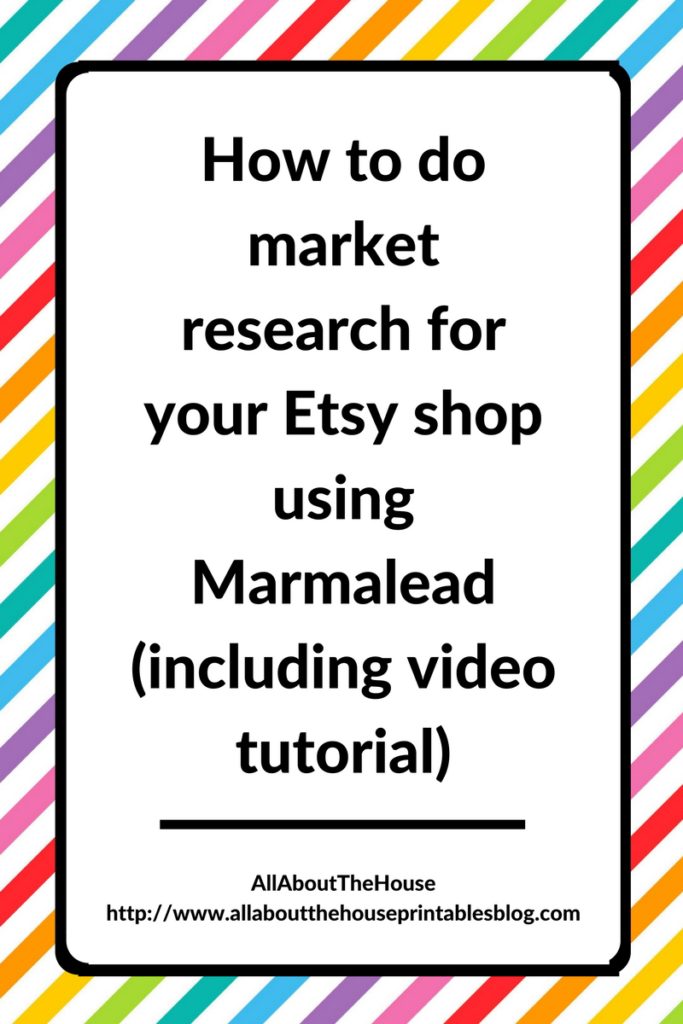 Want to start an Etsy shop but aren’t sure if you’re products will sell?
Want to start an Etsy shop but aren’t sure if you’re products will sell?
Already have an Etsy shop but want to make a new product line or expand an existing one but aren’t sure what size, pattern, color or style/s are going to be popular?
Don’t have an audience you can ask for their opinion on what they’d like to see in your shop?
Not sure what price to charge for your products?
There’s one tool that can answer all of those questions for you (and more) and which I’ve found super helpful for conducting market research for my Etsy shops, AllAboutTheHouse and PaperCravings. The tool is called Marmalead.
Marmalead is an SEO site just for Etsy. Just search a keyword (or keywords) and it will bring up a ton of data that most SEO tools don’t have. There is both a free and paid option – I use the free option which is quite comprehensive!
Some of the reasons I like this tool:
- The average price (so you can determine how much to charge and also whether your cost price is too high adn if the product is going to feasible)
- What keywords are ranking high
- What keywords are NOT ranking high (i.e. which ones you shouldn’t waste your time on)
- Number of views (how much demand
- Number of shops competing (is the market too saturated?)
I’ve recorded a super comprehensive video showing you step-by-step how I conduct market research using Marmalead:
To enlarge the screen, click the square icon in the bottom right hand corner of the video (it will say ‘full screen’ when you hover your mouse over the icon). If you miss a step or need to re-watch you can pause, restart, rewind and rewatch the recording as many times as you need!
Let’s go deeper into each one, using ‘polka dot cushion cover’ as an example:
Tells you how much demand there is for a product
- Tells you the average number of views per week
- Also tells you what categories are the most popular on Etsy
- The number of shops selling those items
- How many items are listed that are using those keywords
- The minimum and maximum price (to help you determine what to charge)
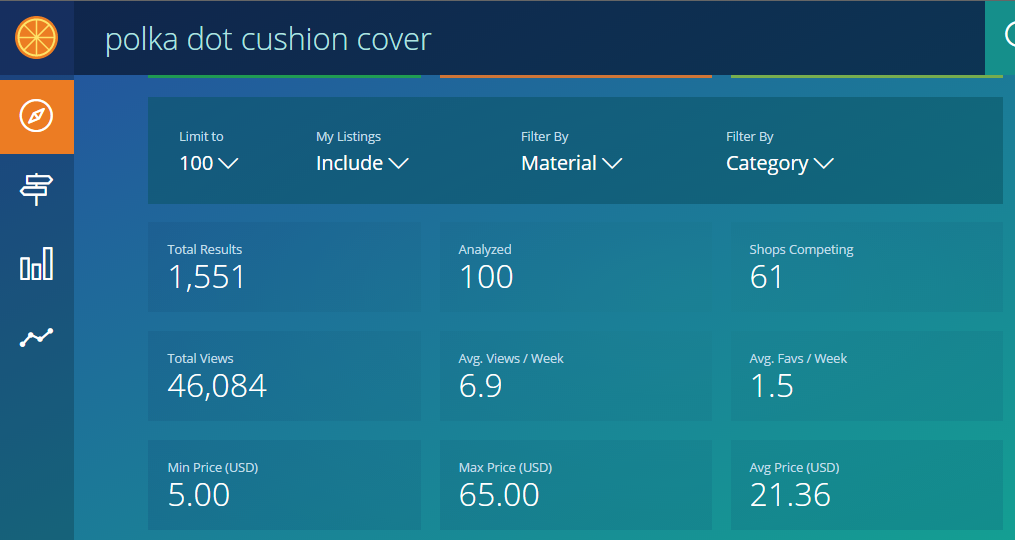
It tells you the average price for that product
- If you’re looking to start selling a new product line (or start a new etsy shop or even an online business) you can use this to determine if it’s feasible (taking into account all of your overheads, paying yourself a wage for your time, supplies etc.)
- The price range – how much are people actually willing to pay – make sure you look at the point on the graph that most pricing falls within. You want your product to fall within this range as well. If it’s likely to be on the high side, possibly reconsider your price, or make sure you’re adding extra value in some way e.g. personalisation that warrants that higher price
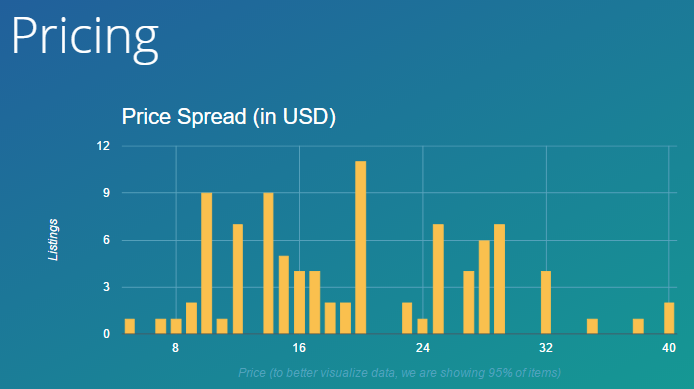
Related: How to organize your Etsy business using a printable planner
It gives you keywords
- There’s a handy word cloud with related keywords you can use for determining your shop tags – you may find some tags you haven’t come across before and that you could be missing out on a lot of views!
I go into this more in the video, but using the world cloud we can see a few patterns and recurring elements that suggest those are popular and what you would focus on when creating your next product:
- Pink and white appear to be the most popular colors. If I were making a new cushion cover range, I would make sure I used pink
- Green doesn’t appear on the world cloud suggesting this is not a popular color
- Cushion cover, pillow cover and decorative pillow appear to be the most popular keywords – I’d make sure I used these as tags for the Etsy listing
- Sizes 16 inch and 18 inch appear to be popular. I would start with making cushions at this size (and square shape as opposed to rectangle)
- Grey also appears to be a popular color. I would look into making grey cuschion covers if the pink ones sell well. A cuchion cover in a grey and pink polka dot pattern would likely also sell well
- Damask also appears. If the polka dot pattern range proved to sell well, I’d then create a cushion cover in a damask pattern
- ‘Modern pillow’ appears. I would look into what styled constitute ‘modern’ e.g. black and white colors, geometric prints etc.
- Anniversary also appears on the word cloud – I would take this into account when writing the product description and considering who you are marketing to. You could also use this to create a personalised cushion e.g. a cushion that says Adam & Emily’s which could be an anniversary gift, or one cushion with the husband’s name and another cushion for the wife’s name
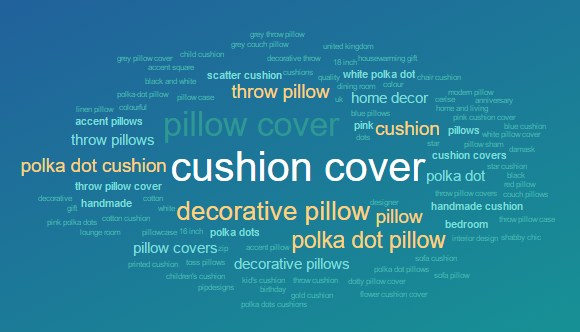
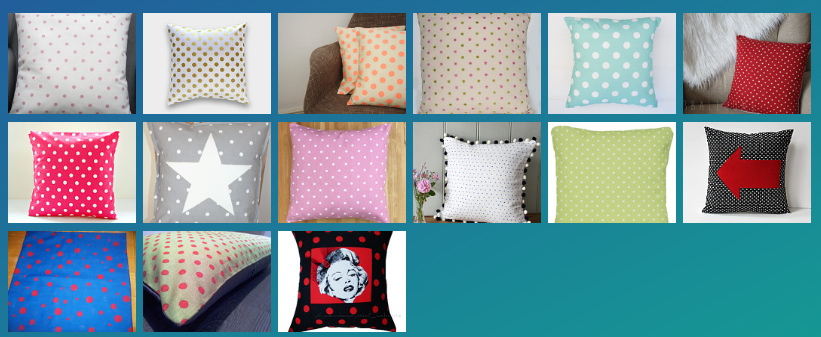
Related: How to organize your taxes with a printable tax planner
It tells you how well ranked keywords are
- Like with the world cloud above, we can see that cushion cover recieves the most searches so not only would I ensure this is a tag for my listing, but I would also place these words at the start of the listing title and in the first paragraph of the listing
- Also make sure you look at the last page of the search results, as this tells you what keywords are NOT ranking (i.e. which keywords you shouldn’t use)
- The average price. In the image below we can see that most cushions are priced at around $20 – $22 so that is what I would price my cushion covers at
- On their paid plan you can also see the amount of competition – by looking at the low, medium and high
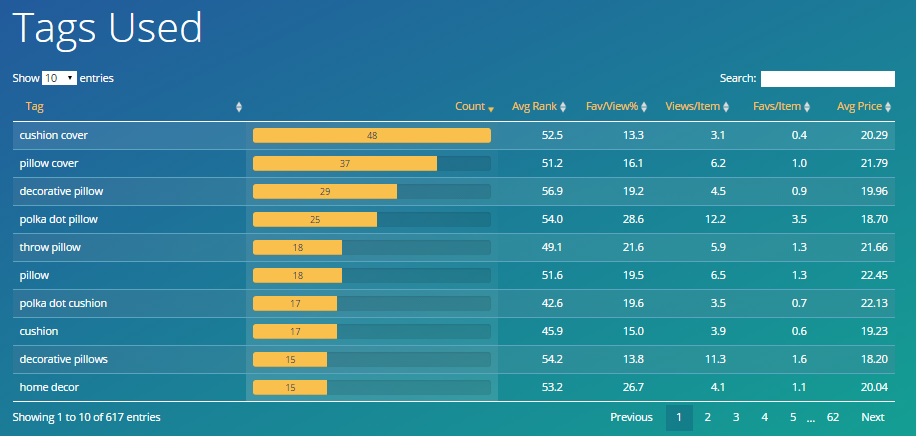
You can look at your competitors
I like to create a Word document and jot down some of the following as I’m conducting market research, so I can easily pinpoint similarities, competitor shortfalls and how I can make my products stand out:
- It tells you how many competitors (Etsy shops) are trying to rank for the same keywords
- Sure you can use Etsy to check your competitor’s stats including looking at their sold items history to see what’s selling (if that Etsy shop hasn’t hidden their sales history) – but Marmalade will tell you more in depth information including how often it’s been favorited, how many views etc.
- You can have a look at multiple competitors and see what the common factors are such as
- The way they present their products in their photos
- How much they charge
- What types of products they sell (for this example, I would see if they only sell cushion covers or if they sell other related items such as quilts)
- Common sizes
- Common styles
- Common colors and color combinations
- Common shapes
- What types of sizes, styles, colors, colors combinations and shapes are NOT selling (suggests there’s a gap in the market or that there is no market)
- How much shops with unique selling points such as personalisation are charging
- Their shop categories – do they arrange by size, color style, shape? Do they have a section for sales, custom orders, best-sellers?
- What their shop banner looks like
- Their about page
- You can click on their listings and a new tab in your internet browser will open taking you to their shop where you can analyse their listings, see what keywords they have in their title, the structure of their product description etc.
- What sort of photos do they have – pay particular attention to how many photos they have and what the first photo is – is it a close up? A long shot, a styled/mockup photo, one showing the product in use?
- What are people favoriting?
- Scroll to the bottom of the competitor shop’s listing and see what tags they’re using
- Read the reviews of the competitors’ shop (pay particular attention to the negative reviews and those that provide feedback such as ‘I wish it had _____’ as these are features you can add to your product to develop a unique selling point)
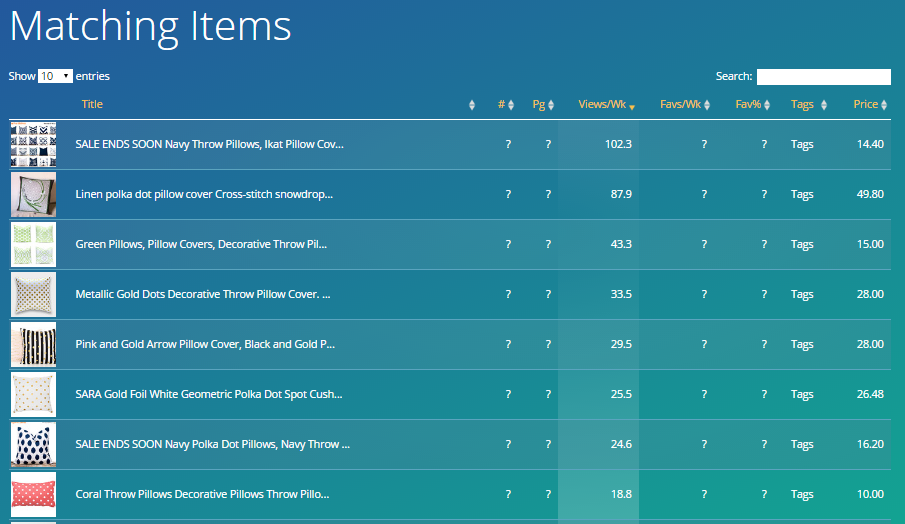
Want more info about how I SEO optomise my shop? It’s all in my ecourse: How to write product descriptions
Included in the course is:
- A 37 minute video where I walk you through EXACTLY how I write a product description (using a product from my own shop as an example)
- A 5 page editable PDF for you to outline your product descriptions – it includes the 14 elements you should include in your product descriptions, what order to place them in and the things most people forget to include
- How I upsell in a non-icky way
- How to choose keywords that help your products get found (including my favorite keyword tools)
- Product photos – how to choose photos, elements all of your photos need and what order they should appear in
- My stock photography directory ebook with over 200 stock photography resources (most are free!) as well as mockup templates for your products

You can learn more about the ebook in this post. The book can be purchased via my main Etsy shop, AllAboutTheHouse or in the online shop.
I was not compensated by Marmalead. All opinions are my own.
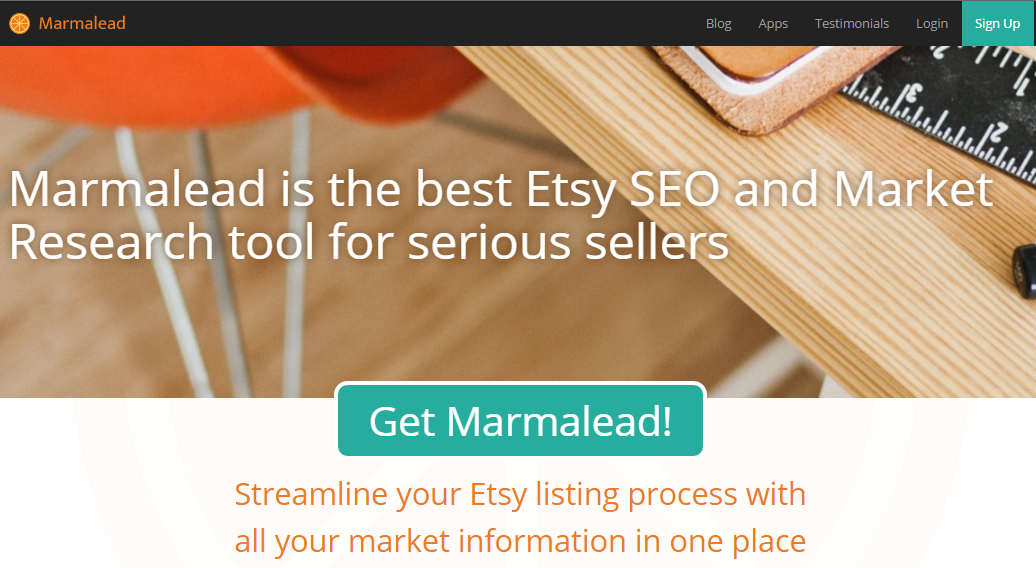
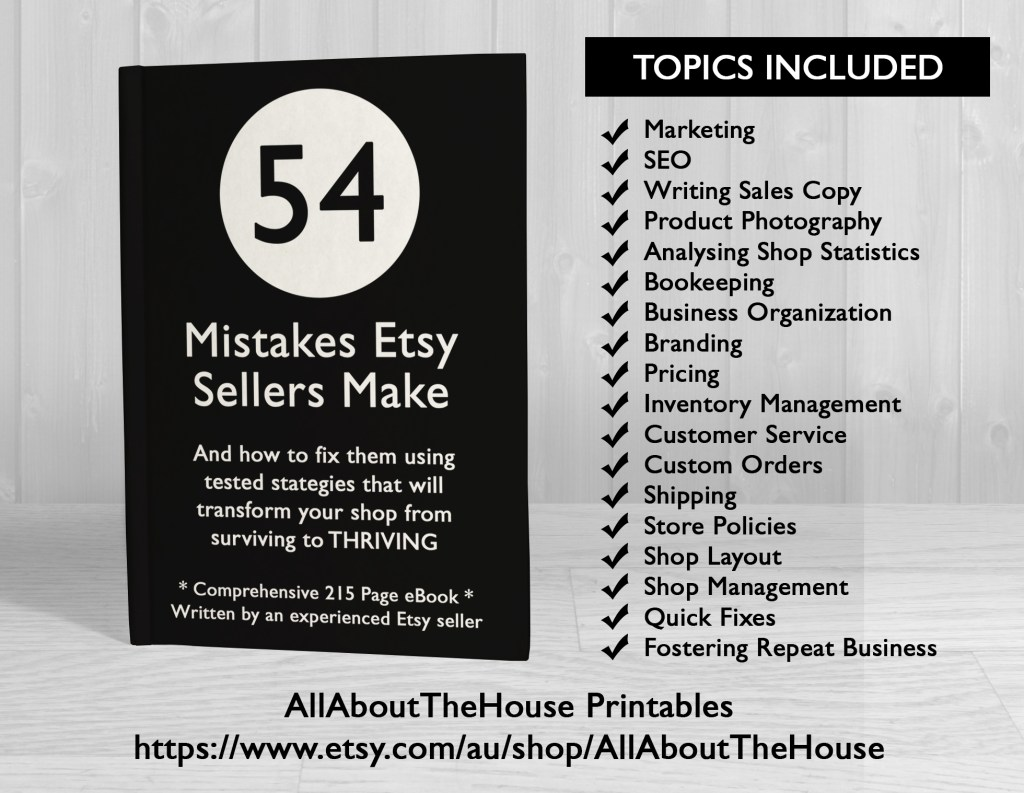
Leave a Reply